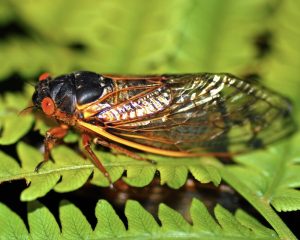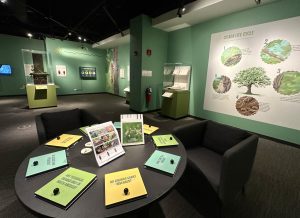Dunn Museum exhibit celebrates cicadas
By Gregory Harutunian For Chronicle Media — May 29, 2024
The periodical cicada makes its return, after a 17-year hibernation period, and the distinctive chirping will fill summer days. (Photo courtesy of Bess Bower Dunn Museum/Jim and Joan Sayre)
Those pesky sounds of the cicadas are beginning to emerge after a 17-year hibernation period.
The Bess Bower Dunn Museum in Libertyville has taken note with a special exhibit, “Celebrating Cicadas,” which runs through Aug. 4. The museum has also launched an online mapping system for people to report locations.
The Periodical Cicada climbs trees, after emerging from the ground, and starts to “sing” with a distinctive chirping, or mating, call. Protective netting has also begun to appear on trees as a covering to prevent their march. They climb the trees to extract themselves from their exoskeleton and hang vertically in doing so.
No one is sure why the hibernation period is 17 years, although the 2024 edition is the result of the last mass emergence in 2007. Cicadas like Illinois and emerge as the soil temperatures approaches 64 degrees and warmer.
“The exhibit is an effort to change the view and perception of people regarding the cicada,” said Alyssa Firkus,” the museum’s director of education. “The last two emergent years were 1990 and 2007. The Lake County Forest Preserve District sites were the go-to places to learn about them. As the cycle goes, this would be the next big year.”
Contained in the special exhibition hall, the museum staff began planning the event five years ago. All the known information is set in displays, along with adding tell-tale signs to look for, in one’s own yard. The life cycle begins when a female cicada lays rice-shaped eggs in the small folds of tree branches near the tip.
Educational components are included on a website (lcfpd.org/education/cicadas/), complete with videos and downloadable coloring pages. Mark Hurley, a museum instructor, will also conduct a “Cicadafest” afternoon search, from noon to 4 p.m., June 9 at the Ryerson Conservation Area in Riverwoods.
The museum notes that forest preserves, parks, yards, and entire neighborhoods can be cicada

The “Celebrating Cicadas” exhibit at the Bess Bower Dunn Museum in Libertyville runs through Aug. 4. (Photo courtesy of Bess Bower Dunn Museum)
hotspots, as millions are expected. A mapping system was created that covers not only Lake County, but outlying areas. The map is easy to view (lcfpd.org/cicada) and uses information submitted from individuals that report their observations.
“It’s fun because you report your observations and you can also see what is being recorded,” said Firkus. “The data is used by us, working with Cicada Safari and iNaturalist, people talking and collaborating about the maps that will be made this year. We have a better understanding of where they emerge, and how many.
“The committee engaged the Geological Information Service, staff, natural resource teams, along with the communications and design teams on how we can best use the community as a resource,” she said. “You get to understand where they emerge, the kind of specific emergence, all in different parts of the county.”
After extracting themselves from their shell, they are soft, with opaque colors of white and yellows. Within 90 minutes, their bodies harden and darken. The unmistakable mating sound is created by tymbals, male abdominal organs that expand and contract. A clicking noise gets more rapid and can reach 100 decibels, comparable to a motorcycle.
“This is the big year, and an exciting natural event,” said Firkus. “The next one will be in 2041. We’re hoping we will have accurate mapping for the area, and we can continue to build on our knowledge. It will be fun to look back on this cycle now, in another 17 years.”
The Bess Bower Dunn Museum, 1899 W. Winchester Road, Libertyville, is part of the Lake County Forest Preserve District.







